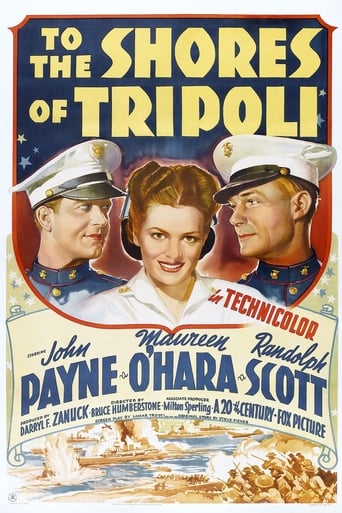Duesenberger
As a slice of cinematic history, this film is worth watching. It was clear to me that it must have been written, and production largely completed before December 7, 1941. I'd like to see if there is any historical evidence of this.There was no reference in the film to the global conflict in which Europe and Asia were involved at the time until the last minutes of the film. I wonder how the original script ended? Most shocking is the brief shot at the end during the final marching parade where an older Asian man is shown cheering the marines as they march on by. The man is replete with "Foomanchoo" mustache and holding a sign saying "Me Chinese" while waiving a small American flag. Rarely was Hollywood so blatantly racist.The early Technicolor looks colorized by today's standards and yet beautiful for its time. I could have done without the endless marching and parade grounds scenes which took over most of the movie.
bkoganbing
Stepping into the hero/heel part that Tyrone Power specialized in while at 20th Century Fox is John Payne as the spoiled kid of a former Marine officer, Minor Watson. Payne's hoping to get out of the Marines for a nice desk job in Washington, DC, but Watson's hoping that his former sergeant Randolph Scott, now a drill instructor will give Payne the necessary attitude adjustment.Payne's getting an attitude adjustment in another direction too. He's fallen for pretty nurse Maureen O'Hara even though he's got Washington society girl Nancy Kelly pulling strings for him.The part is such a perfect one for Tyrone Power that I'm sure it was offered to him and rejected and given to Payne who was hired by Darryl Zanuck because of his resemblance to Power and the fact he could sing opposite Alice Faye and Betty Grable. Power did similar roles in A Yank in the Raf and Crash Dive and in fact did serve in the Marines in the South Pacific after 1943. The film was shot on location at the San Diego Marine training station and I visited San Diego a few years back and some of it looks pretty much the same. Harry Morgan made his feature film debut and if you look close you'll see that another one of the Marine recruits is the Skipper himself, Alan Hale, Jr.To the Shores of Tripoli is badly dated and doesn't play real well against today's attitudes. Still it's a great example of a World War II propaganda piece.
holy1
I agree with the evaluation of bsmith5552 that it is a disappointing flagwaver, and essentially a U.S.Marine recruitment film. But it has its own place in history. I have just been refreshed as to that place in history by watching again the film version of Leon Uris's first (and maybe best) novel, Battle Cry. Uris dramatized his own experience as a young marine, first training in the States, then in Wellington and elsewhere in New Zealand and finally fighting in the islands of the Pacific He has a fascinating picture of what it was like for young Americans to find themselves in a strange and previously unheard of land like New Zealand. I was a Kiwi teenager in Wellington at that time and can vouch for the accuracy of Uris' depiction of the impact of the descent of thousands of young marines on our city and of their interaction with the locals. To the Shores of Tripoli screened in Wellington in 1942, not long after Pearl Harbor, in the time the newly formed Marine Divisions were there preparing for their involvement in the war in the South Pacific. Through that film we saw on our screens the training only months earlier of the men who were now in our midst. Bsmith5552 speaks of the repetitive sequences of close order drill. I watched the marine band perform those intricate marching exercises in colour film in a local cinema ("picture theatre" in our brand of English). This was the same week I saw them do it live in Wellington. I was transfixed as I saw utterly committed young marines rise and stand to attention in their places in the cinema as the Marines Hymn came through on the film's sound track. I was not simply present at a piece of entertainment. I was watching live drama. To the Shores of Tripoli may not have been a great movie. But in the South Pacific in 1942, when we (maybe unlike today's Iraquis) welcomed the Marines as life savers, preserving us from a Japanese invasion, it had its place in the drama of that time. I viewed it sixty years ago with great interest. I would like the little niche it has in cinema history to be remembered.
WarnersBrother
This plot of this film- selfish rich boy joins the armed forces and by turns is converted into a red-blooded selfless team player- is often called cliche'. However, you have to bear in mind that it wasn't at the time it was made; It was one of the genre of plots that became cliche' latter (In fact, it is basically a color remake of "I Wanted Wings"...a much better film IMHO... substituting the Marines for the Air Corps.)But what it does have is a great cast, great production values and the distinction of the first pairing the lovely Maureen O'Hara, stunning in beautiful early Technicolor, and John Payne. Arguably this is one of the great, if minor, pairings of the 40's ("Sentimental Journey", "Miracle on 34th Street", etc.) that culminated in a return to the Marine/Tripoli theme: In 1950 the pair would almost single-handedly capture the city in "Tripoli".Is it great cinema? Nah...but it's a fun picture to watch for buffs.


